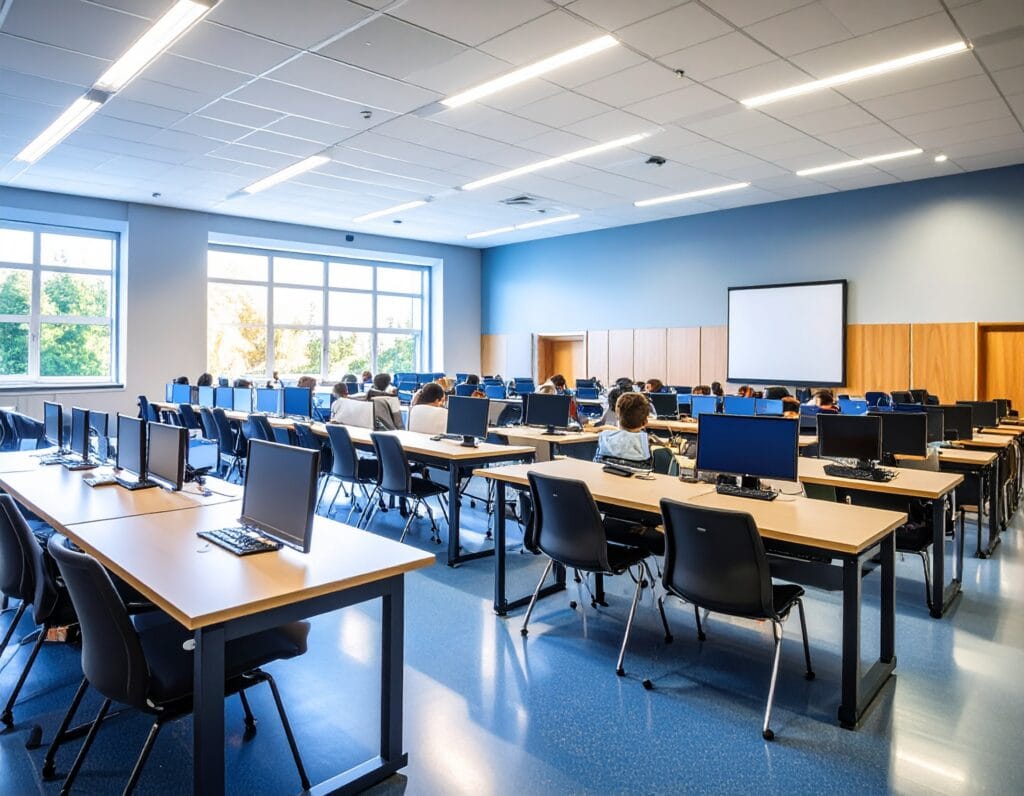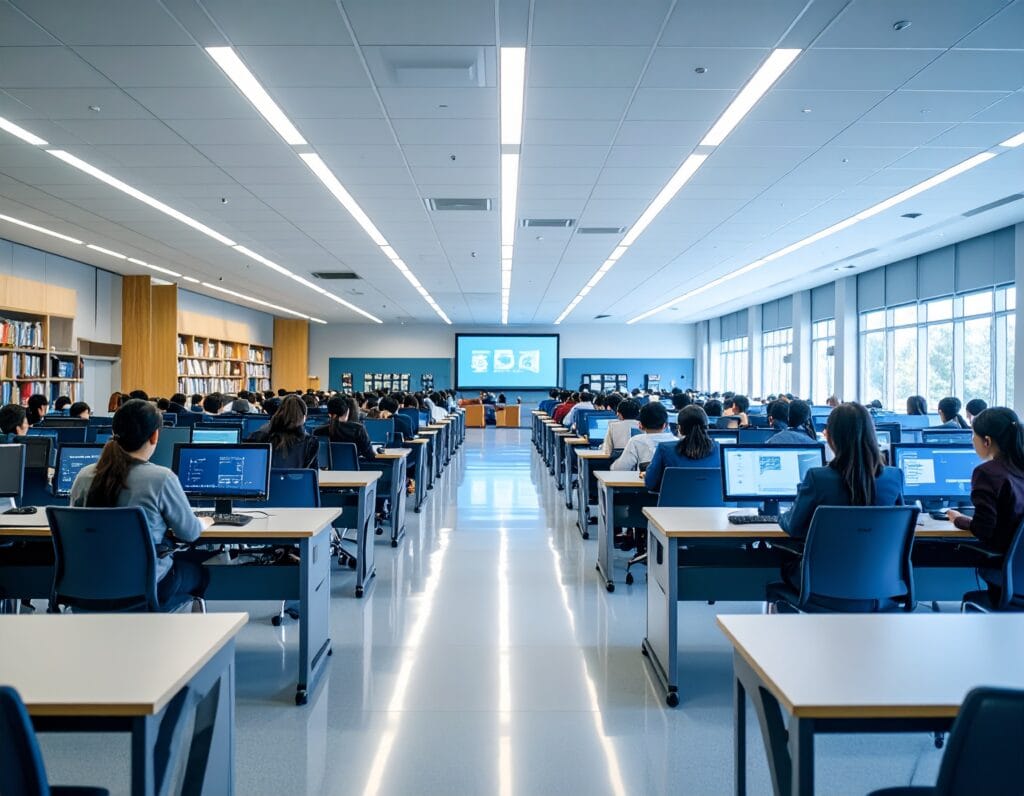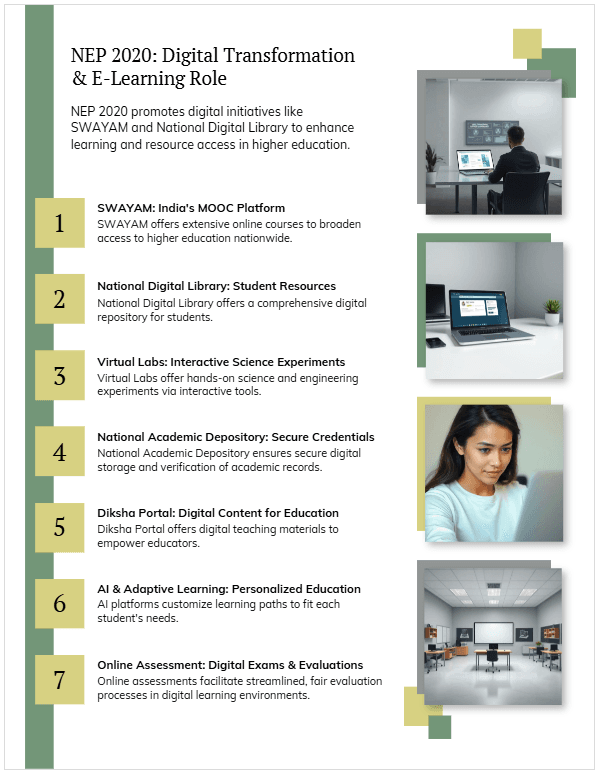The National Education Policy 2020 (NEP 2020) is an important step towards revolutionising India’s education system. The policy emphasises on promoting digital transformation in higher education and establishing e-learning as an effective educational medium. This paper analyses the use of digital technologies in higher education under NEP 2020, the role of e-learning and its implications. At the same time, the challenges posed by digital transformation and their solutions have also been discussed. The objective of this research is to understand the impact of digital education and propose strategies to enhance its effectiveness.
According to NEP 2020, digital transformation in higher education is not just limited to changing the way education is imparted, but it is also the medium to make the process of learning and teaching more effective, engaging and inclusive. The use of technologies such as e-learning platforms, digital resources, online courses and artificial intelligence has opened up new possibilities of communication between teachers and students. Under this policy, emphasis has been laid on the formal inclusion of online education in higher education institutions, so that students get an opportunity to get quality education, no matter where they are.
The future of digital education under NEP 2020 looks bright. Digital transformation in higher education in India is gradually strengthening its roots and can become an integral part of the education system in the coming years. Blended learning, edtech startups, virtual classrooms and artificial intelligence-based learning can completely change the landscape of higher education.
However, the government, educational institutions, teachers and students have to work together to ensure the effectiveness of digital education. Continuous efforts have to be made to improve digital literacy, infrastructure development and quality of education.
National Education Policy 2020, Higher education, digital transformation, e-learning, online education
Introduction E-LEARNING –
Importance of technological revolution and digital transformation in the field of education. Education is the foundation of the development of a society, and it is necessary to change it over time so that it remains in harmony with the needs of the present and the future. In the 21st century, the technological revolution and digital transformation have provided a new dimension to the education system. Traditional teaching methods, which were mainly dependent on books, classroom lectures and direct teaching, have now become more advanced and accessible with digital technology. Education is being made more inclusive, effective and interesting through modern technological tools such as Internet, Smartphones, Online Learning Platforms, Artificial Intelligence (AI) Virtual Reality (VR) Big Data Analytics, Cloud Computing, and Blockchain technology.

The technological revolution and digital transformation have brought many important changes in the field of education. Firstly, it has been instrumental in increasing the accessibility of education. Now students can take online courses from reputed universities and educational institutions across the world, free from geographical boundaries. Especially in rural areas, where access to quality education was limited, digital technologies have provided equal opportunities to students. For example, online platforms like SWAYAM, NPTEL, Coursera, edX, Udemy have made quality education available to millions of students.
The second important aspect is flexibility. In the traditional education system, students were required to attend class at a fixed time, but through digital education, students can now study as per their convenience. Facilities like recorded lectures, e-books, online assignments and digital libraries have made education more personalised learning. Artificial Intelligence and Machine Learning based adaptive learning has made it possible to design courses keeping in mind the individual learning pace and needs of the students.
The third major impact is the improvement in the quality of education. The use of digital technologies has also given teachers better resources and tools, allowing them to teach more effectively. Interactive elements like virtual labs, simulations, 3D modelling, and multimedia content have made teaching more practical and interesting. Especially in science and technical education, complex topics can be easily explained using virtual reality and augmented reality.
The fourth important aspect is digital assessment and evaluation. In place of traditional examinations, online examination system, automated evaluation, and data analysis-based feedback system are now being adopted. This has not only improved the quality of teaching but also made the evaluation process more transparent and accurate.

Impact of National Education Policy 2020 on Digital Education in Higher Education
The National Education Policy 2020 (NEP 2020) is an important step towards the modernisation of the education system in India. The policy lays emphasis on making education more inclusive, flexible and technologically enabled. This policy presents several important reforms and aspects to promote digital education in higher education, which is benefiting students, teachers and educational institutions at large.
Institutional framework of online and digital education NEP 2020 provides a strong institutional framework for mainstreaming digital education in higher education. Under this, National Digital Education Architecture (NDEAR) and National Educational Technology Forum (NETF) have been established, which will help in developing strategies, research and resources of digital education. These institutions are working on infrastructure, teacher training and curriculum development required for online education.
Online courses and e-learning platform
Massive Open Online Courses (MOOCs) have been promoted in higher education under NEP 2020. Various digital platforms have been developed for this, such as:
- SWAYAM: It is an e-learning platform developed by the Government of India, which makes available various courses for higher education free of cost or at a minimal fee.
- NPTEL (National Programme on Technology Enhanced Learning) provides online courses for engineering and science subjects.
- e-PG Pathshala: A digital resource platform for postgraduate level studies.
- DIKSHA: A digital platform for teacher training and school education.
Facilitation of Blended Learning
NEP 2020 recommends the adoption of Blended Learning in higher education; wherein traditional classroom teaching is combined with digital learning tools. This system provides students with flexible learning opportunities and gives teachers the freedom to adopt more interactive and effective teaching methods.
Establishment of digital universities.
The government is planning to set up a National Digital University under NEP 2020 to increase access to digital resources in higher education. The university will be completely online and will offer certificate, degree and diploma programmes in various disciplines.
Accessibility and Inclusivity of Higher Education
NEP 2020 aims to make quality higher education accessible to all through digital education. This will also provide an opportunity to students from rural and remote areas to pursue higher education. The availability of e-learning resources will also provide opportunities for higher education to differently-abled students and working professionals.
Digital Assessment and Certification System
In NEP 2020, it has been recommended to adopt digital assessment system to modernise the traditional examination system. The performance of students can be assessed with greater accuracy and transparency through online examinations, automated grading systems and data analysis-based assessment.
Use of artificial intelligence (AI) and latest technologies in digital education
Under NEP 2020, higher education institutions have been motivated to adopt technologies such as Artificial Intelligence (AI) Machine Learning, Big Data, Blockchain and Cloud Computing. This will promote personalised learning, data driven teaching and research.
Challenges and Solutions of Digital Transformation
However, there are also several challenges in adopting digital education under NEP 2020, such as:
Digital Divide: Lack of access to digital resources to students from rural and economically weaker sections.
- Internet connectivity and technical infrastructure: non-availability of high-speed internet in remote areas.
- Digital Literacy Training of Teachers: The use of digital tools is not intuitive for all teachers.
- Quality control: Maintaining the quality and authenticity of online education.
To address these challenges, the government is running digital literacy campaigns, providing special grants for digital education and promoting public-private partnerships (PPP).

Accessibility and inclusiveness of education through e-learning
E-learning has become an integral part of the modern education system. It is a digital alternative to traditional teaching methods, enabling the exchange of knowledge through the Internet and technological resources. The National Education Policy 2020 (NEP 2020) seeks to make e-learning more inclusive and accessible by promoting it in higher education. This digital revolution is proving to be especially beneficial for students who were deprived of the traditional education system due to geographical, economic, or social reasons.
1. How did e-learning increase accessibility of education?
Education through e-learning is now reaching even those sections for whom traditional educational institutions were difficult to reach. It is increasing the accessibility of education in several ways:
Freedom from geographical boundaries – e-learning has freed students from the need to be confined to a specific location. Now the students of far flung and rural areas can also take advantage of the courses of reputed institutions of the country and abroad.
Freedom of time – In e-learning, there is no fixed time for study, so that students can study at any time as per their convenience.
Low-cost education – Education has now become more affordable due to the availability of online courses and digital content. Students get relief from expensive courses and living expenses.
Adaptation for students with special needs – E-learning is particularly helpful for students with disabilities. These students can easily study through voice-assisted technology, screen readers and other digital tools.

2. How did e-learning increase the inclusivity of education?
E-learning has made education more inclusive for different sections of the society. This is manifested in the following aspects:
- Increased educational opportunities for women – Women were deprived of traditional education due to many social and cultural barriers. Through e-learning, they can get higher education at home and take advantage of job-oriented courses.
- Education Opportunities for Working Professionals – It is difficult for employed persons to take regular classes. E-learning has provided them an opportunity to pursue higher education along with their workplace responsibilities.
- Availability of education in different languages – Online education platforms are now providing content in different Indian languages as well, providing quality education to non-English speaking students.
- Opportunities for disadvantaged communities – Students from economically weaker sections are getting many free and low-cost courses on digital education platforms, allowing them to pursue higher education as well.
Government initiatives to promote e-learning
Government of India has launched several policies and schemes to make e-learning accessible and inclusive:
- SWAYAM (Study Webs of Active Learning for Young Aspiring Minds) – It is an online platform, which offers free courses of various universities and institutions.
- DIKSHA (Digital Infrastructure for Knowledge Sharing) – a platform to provide digital curriculum and study material for teachers and students.
- NPTEL (National Programme on Technology Enhanced Learning) – a leading platform for online courses for engineering and technical education.
- e-PG Pathshala – ensures availability of high-quality digital resources for post-graduate education.
PM eVidya – a comprehensive digital education initiative for school and higher education.
Challenges and solutions of e-learning
Although e-learning has promoted accessibility and inclusivity of education, it also has some challenges:
- Digital Divide – Rural and economically weaker sections lack access to internet and digital devices. Solution: The government is working to strengthen the digital infrastructure and provide low-cost tools.
- Problem of internet connectivity – Many remote areas do not have access to fast internet. Solution: 5G and broadband expansion projects can solve this problem.
Lack of digital literacy of teachers and students – Teachers and students need technical training to make effective use of digital resources. Solution: Organising digital literacy campaigns and training programs. - Quality control – It is necessary to maintain the quality and authenticity of online courses.
Solution: Promote courses certified by the government and educational institutions.
Traditional Education vs. Digital Education:
A Comparative Study Education is the basis of the development of society, and new changes are seen in it with time. Traditional education and digital education are two major learning systems, each with its own characteristics, advantages and challenges. In the traditional education system, the teaching-learning process is face-to-face, while digital education operates through the Internet, smartphones, computers and other digital resources. Digital education has been promoted in higher education under the National Education Policy 2020 (NEP 2020). Various aspects of both the systems have been reviewed in this comparative study.
(a) Traditional education.
Traditional education is an educational system in which teachers and students interact face-to-face. It involves physical attendance, classroom-based learning, use of textbooks and study as per a pre-determined time table. Schools, colleges and universities are its main institutions.
(b) digital education.
Digital education is a modern teaching system, which uses the Internet, online courses, e-learning platforms, video lectures, virtual classrooms and other technological means. In this, students can study as per their convenience and take advantage of various digital resources.
Comparative Study: Traditional vs Digital Education
| Aspect | Traditional Education | Digital Education |
| Teaching Method | Face-to-face classroom teaching | Teaching via online platforms |
| Communication | Direct interaction between teacher and student | Virtual interaction (video, chat, email) |
| Accessibility | Limited to school/college premises | Learning possible anytime, anywhere |
| Flexibility | Fixed schedule and location | Students can learn at their own convenience |
| Learning Material | Books, notes, blackboard | E-books, video lectures, digital notes |
| Practical Education | Through labs and fieldwork | Use of simulations, virtual labs, augmented reality |
| Examination & Evaluation | Written exams and direct assessment | Online exams, automated evaluation |
| Cost | Higher cost (fees, transport, books, etc.) | Comparatively cost-effective |
| Inclusivity | Only physically present students can benefit | More suitable for differently-abled, remote, and working learners |
| Learning Experience | Based on practical, social, and moral values | Self-paced and technologically enriched |
| Technical Requirements | Minimal technical needs | Requires internet, smartphone, or laptop |
| Role of Teachers | Teachers provide direct guidance | Teachers offer limited guidance through digital platforms |
The Future of Digital and Traditional Education – A Balanced Approach
The National Education Policy 2020 promotes digital education, but it cannot completely replace traditional education. So there is a need to adopt blended learning or blended education system.
Advantages of blended learning:
Balanced use of classroom teaching and online resources.
A more flexible and effective learning experience for students.
Inclusion of social benefits of traditional education and technological benefits of digital education.
Speed of personal learning and development of digital skills.
Trends and Future Prospects of Digital Education in India
Current Trends in Digital Education in India
The following major trends are being observed in the adoption of digital education in India:
(a) Expansion of e-learning platform
Platforms like SWAYAM, DIKSHA, e-PG Pathshala, NPTEL, Coursera, Udemy, BYJU’S, Unacademy are providing a comprehensive experience of digital education to students and teachers.
Many universities and educational institutions are now making their courses available online.
b) Government initiatives to promote online education
National Digital Education Architecture (NDEAR) – to strengthen the digital learning infrastructure.
PM eVidya – digital education platform for school and higher education.
DIKSHA (Digital Infrastructure for Knowledge Sharing) – for school and teacher training.
Gyan Darshan and Swayam Prabha – Spreading digital education through Doordarshan and DTH.
(c) Increasing access to smartphones and the Internet
Affordable smartphones and cheap data plans in India (because of Jio and other companies) have been instrumental in spreading digital education.
E-learning is gaining momentum with the increase in internet connectivity even in rural areas.
Increasing use of Artificial Intelligence (AI) and Virtual Reality (VR)
AI-based personalised learning helps students learn according to their understanding and pace.
Practical subjects can be taught more effectively through virtual reality (VR) and augmented reality (AR).
The National Education Policy 2020 has recognised the importance of digital education in higher education and proposed various reforms to promote it. E-learning has made higher education more accessible, flexible and inclusive, giving students the opportunity to learn according to their needs. Digital transformation has not only improved the quality of education but also made the teaching-learning process more effective and modern.
However, there are also many challenges facing digital education, including the digital divide, lack of infrastructure, and limited access to technological resources. It will be necessary to increase the accessibility of digital resources and technical efficiency of teachers in order to fully benefit from digital education, especially to students from rural and disadvantaged sections.
Promoting digital literacy, improving infrastructure, and training of teachers are essential to make e-learning effective. Innovation in teaching methodologies and incorporation of emerging technologies such as Artificial Intelligence, Virtual Reality, and Blockchain certification can further enhance the effectiveness of digital education.
A more comprehensive and effective implementation of digital education in the future will require policy-making and innovation. The government, educational institutions and technology experts will have to work together on solutions that can make digital education inclusive and quality. If these challenges are addressed, digital education will be able to bring about a revolutionary change in India’s higher education system.
References
- National Education Policy 2020, Ministry of Human Resource Development, Government of India.
- UGC Online Education Regulations 2020, University Grants Commission (UGC).
Impact of SWAYAM and e-learning platform, Government of India, Digital India initiative.
e-Learning: Opportunities and Challenges in the Indian Context, a research paper by Indian Institute of Technology (IIT) Delhi. - Digital Education and Transformation in Higher Education, Indian Council of Social Science Research (ICSSR).
- A comparative study on the impact of e-learning in higher education, research paper published by Aligarh Muslim University (AMU).
- Digital Transformation in Education and the State of Indian Universities, Research of Jawaharlal Nehru University (JNU).
- Digital Divide in India: Impact on Higher Education, Tata Institute of Social Sciences (TISS).
- E-learning and traditional education: benefits and limitations, Indian Institute of Management (IIM) Bangalore.
- Digital Teaching and Learning Challenges: A Holistic Approach, a research paper by Banaras Hindu University (BHU).
- Digital India and Technological Development in Higher Education, Ministry of Science and Technology, Government of India.
- Prospects and Challenges of Online Education in India, Report of the Union Ministry of Education.
- Role and Future of Digital Education in Higher Education, Research of the University of Kerala.
- Impact of online education after COVID-19: A case study, University of Mumbai study.
Digital Education Policy in India and its Impact, Amity University.


